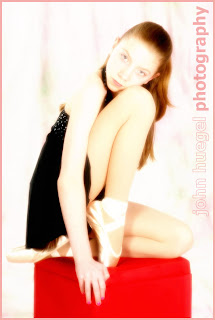
Yesterday I conducted an all-day dance studio photography session. I do these each year, and take pride in the excellent images that I produce with my camera, lights and backdrops. This Sunday, I shot in excess of 1400 images in seven hours, resulting in 450 proofs, or "keepers". That 3:1 ratio of shots to keepers is pretty consistent with my style.
I use a four-light setup for most of my dance images: one for backdrop, one for a hair light, and a main and fill light. I have fiddled with the settings over the years, but I my method is repeatable and gives me good results. I know how to set my camera in manual mode to end up with the correct exposure.
One Small Change Causes Large Problems
My indoor lights are pretty strong, consisting of three Alien Bees AB400's and one AB800 modified with brolly boxes. I used to shoot with a polarizing filter on the lens, which effectively dropped 2 stops from the light level. In an effort to create sharper images, I eliminated the polarizing filter, which results in more light reaching the sensor.
This puts me in a tight shooting position. I have a 1/250 sec limit on my strobes, meaning I had to either move the f-stop higher (less light), or drop the light levels (tweak the output). I'm down to 1/32 level on my lights, and at that level, their output level is a lot less consistent than at 1/4 or higher. If I stop down the lens, I end up with a depth of field that is too wide, and the backdrop is too sharp for my taste.
So, my balancing act is between f-stop and light level. I tried to keep the f-stop low so I could control depth of focus, and ended up at the minimal range of my strobes...and at that level, they have far more shot-to-shot lighting variability than I have previously seen. It's not the end of the world, but the lack of lighting consistency means that I need to put in far more backend time on image exposure correction.
My conclusion from reviewing the images is I need to raise my lighting levels and get more consistent and brighter illumination in my particular dance studio setup. But what I really need is to become literate in the use of a light meter, so I get it right without needing to experiment so much. The light meter will tell me when I have the exposure right, without needing to shoot, upload and look.
Becoming One With The Camera
I've been doing photography for several years and have done well with the images I took, but I am always disappointed in some element of my exposure or technique. For example, I nudged the back of my camera and inadvertently set the shutter speed to 1/320 by accident. This puts the camera's shutter speed beyond the range of the flash control. I shot ten images before I looked and saw the telltale black fringe at the left side of the image, created by the shutter movement. I've seen it before, and immediately knew what caused it. So how did I compensate? I started looking at the f/stop and shutter speed indicator in the viewfinder as I pressed the shutter. I glanced and made sure that I saw "1/250 3.5" in the LED display at the bottom of the viewfinder eyepiece display. That way I knew my parameters were what I intended them to be.
The next issue I saw was with my wireless flash trigger. On rare occasions, it would not fire. The telltale clue would be the black image in the viewfinder, as my exposure settings without flash would have been dark in the room I was using. But I don't look at every image, as I'm shooting pretty quickly. I found that if I paused for 1/2 second after the shot and unfocused my eyes from the viewfinder, I could see the "color" of the image in the camera display, right between my eyes. It's hard to explain, but I learned to anticipate the brightness of the preview image and see it in my peripheral vision in between shots. It's a level of interaction with my camera that I had not had before, and it is coming in very handy.
And, In The End...
Every time I shoot I learn things. Yesterday I discovered that my small setup change caused a lot of ripple effects in my environment and my images. I learned to verify my exposure in the viewfinder as I pressed the shutter, and verify flash fire with my peripheral vision. But what I really learned was that I am far from satisfied with my own consistency of technique and lighting skills. Nick Onken, who has a blog called Shoptalk, believes that you reach proficiency in your art once you have invested at least 10,000 hours in it. For full time people, that's 5-6 years of living and breathing your chosen field. For folks like me who multitask and work at this business part-time, I think it's decades before we hit that level. What we gain in balance and experience from other career paths, we have to make up with inexperience compared to our full-time brethren.